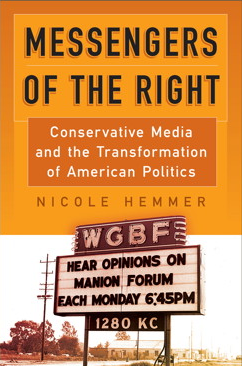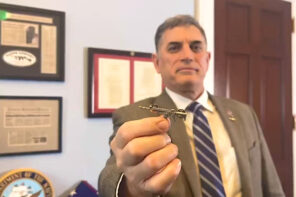It might be hard for those of us who critique mainstream media for its complacency or sensationalism to take the accusation of liberal bias too seriously. If news has become entertainment, it is not because of its stealth progressive agenda.
But “liberal bias,” this decades-old conservative critique, was one of the first tremors of public doubt in the trustworthiness of news. And now look where we are.
The time could not be more right for Nicole Hemmer’s new book, Messengers of the Right: Conservative Media and the Transformation of American Politics, which tells the origin story of activist conservative media.
RD’s Eric C. Miller spoke with Hemmer about the role of religion in the rise of the first generation of conservative media, and the ascendancy of the right’s new outlets and experts, from Glenn Beck to Breitbart.
_________
Eric C. Miller: You identify Rush Limbaugh and Fox News as “second generation” conservative media institutions. Who were their predecessors? How far back do they go?
All the way back to the mid-1940s! The first generation begins with the founding of Human Events, a little four-page newsletter published out of Chicago. Human Events grew out of the anti-intervention movement in World War II, both in terms of personnel and patrons. Its founders, Frank Hanighen and Felix Morley, were conservative pacifists who drew their start-up funds from some of the most prominent members of the America First Committee.
When Hanighen and Morley launched Human Events in 1944, their goal was to further a non-interventionist foreign policy to promote a lasting peace after the war ended.
That may not sound like it has much to do with the postwar conservative movement. But as Human Events developed, it focused increasingly on national sovereignty, limited government, and anti-communism.

Messengers of the Right: Conservative Media and Transformation of American Politics
Nicole Hemmer
University of Pennsylvania Press
August 2016
Hanighen and Morley brought on a young Chicagoan named Henry Regnery to handle their promotional work. Regnery soon got the publishing bug, and left Human Events to start his own company, Regnery Publishing. Soon he was putting out some of the most important conservative books of the era, including William F. Buckley’s God and Man at Yale (1951) and Russell Kirk’s The Conservative Mind (1953).
It was in this moment, the early 1950s, that conservative media outlets began to multiply. In 1954, Clarence Manion, a former dean of Notre Dame Law and a refugee from the Eisenhower administration, started his weekly radio program, the Manion Forum. He was soon joined by fellow broadcaster Dan Smoot. And just one year after that, in 1955, Buckley brought together a talented group of conservative writers at his new magazine National Review. William Rusher, another major figure in the first generation, joined National Review as its publisher in 1957.
By the mid-1950s, then, there were a number of conservative periodicals, publishing houses, and radio shows. And they weren’t just isolated outlets scattered across the country. They were intimately connected through overlapping donors, personnel, and relationships.
Regnery was an early sponsor of the Manion Forum. Manion sat on the board of National Weekly, which oversaw National Review. Editors at Human Events and National Review appeared on the Manion Forum and wrote for Regnery. These conservative media activists didn’t agree on everything—in fact, they often fought over which politicians to support, what policies to promote, and where to draw the boundaries of conservatism. But at the end of the day, they all agreed that the best way to advance conservative politics was through conservative media.
Contemporary conservative media personalities tend to draw pretty heavily on a God-and-Country ethos. Were these earlier figures overtly religious?
Yes, but in different ways depending on the person in question. The first generation of conservative media activists can be divided into two groups. The central figures, like Manion, Regnery, and Rusher, were driven primarily by politics. Their religious faith informed their politics, but religion was not their central cause. Another, somewhat tangential group like Billy James Hargis of Christian Crusade and Carl McIntire of The Twentieth Century Reformation Hour wanted to win souls first, votes second.
Though there was a lot of common ground between these two groups—they were committed anticommunists and anti-New Dealers—the organizational ties between them were quite thin. In the 1950s and 1960s, the Christian right was distinct from the conservative movement.
That’s not to say, however, that figures in the political right were not overtly religious. The history of Catholic anticommunism has been well documented by historians like Patrick Allitt. But the religious faith of someone like Clarence Manion went much further than that—it was integral to his theory of government.
Manion believed that the restraints of a religious moral code were necessary to keep government small. A people who lived by religious edicts would not need government regulation to create a well-functioning society. So long as society was godly, government could remain small.
In the 1960s, atheism became a new dividing line at National Review. In 1964 long-time contributing editor Max Eastman published a piece in the magazine asking if atheists could be conservatives. Buckley answered with a resounding “no,” and Eastman left the magazine shortly thereafter.
But honestly, these conservative media figures run the gamut when it comes to religion. Rusher rarely had much to say on the matter. Human Events grew out of a Quaker devotion to pacifism that soon dissipated. Brent Bozell, Buckley’s brother-in-law, broke with National Review because he felt the magazine was insufficiently Catholic. Though, to be fair, Bozell also broke with the Catholic Church during the Vatican II reforms because he felt the Church itself was insufficiently Catholic.
At what point did conservative media become activist, and why?
Great question. There were conservative media—or rather, media outlets that were conservative—well before the 1940s and 1950s, when my book starts. They were mostly newspapermen, like Robert McCormick at the Chicago Tribune, Frank Gannett of the Gannett Corporation, and William Hearst of the Hearst conglomerate.
These men did reach out beyond the pages of their papers to try to influence politics. Gannett, a devoted anti-New Dealer, founded the National Committee to Uphold Constitutional Government in 1937 to counter Roosevelt’s Court-packing plan. In 1940 he launched a quixotic presidential bid. McCormick was heavily involved with the GOP before bolting the party in 1952 and starting For America, a PAC aimed at promoting conservative politicians.
So there’s a tradition of activism within media. But these efforts weren’t movements; they were short-lived and generally the expression of a single personality, without ties to other organizations and efforts. And perhaps most important, the activism was secondary to the media work.
For the folks in my book, deciding to start media outlets was itself a political act. Manion, Rusher, Regnery, Buckley—they all saw their efforts in the media as a way of advancing conservative ideas and therefore politics.
Almost immediately, these media activists were moving into movement organizing and electoral politics. Manion was campaign manager for a third-party ticket in 1956 and the prime mover of Americans for Goldwater in 1960. National Review editors organized a rally against Khrushchev’s visit in 1959. The next year Young Americans for Freedom, a central organization of the conservative movement, was born at Buckley’s Connecticut estate.
The infrastructure of the modern conservative movement was built by media activists—the outlets, the organizations, the politics. It was a distinctly new type of activism, and one that has shaped American conservatism for more than half a century.
Given how influential conservative media has been over the last fifty or sixty years, why has so much attention been given to the sinister liberal media?
The two go hand-in-hand. When media activists were first getting their start, they had to do more than sell Americans on conservative ideas. They had to discredit the established media. That’s because in mid-century, most Americans believed that the news they heard on networks and read in newspapers was objective.
That wasn’t just some superficial belief, either. It was a core faith. After decades spent fighting totalitarianism, authoritarianism, communism, most Americans agreed that the special genius of the American system was that it had moved past –isms, that the era of ideology was over, and the era of a cool-headed, technocratic society was at hand. While there was plenty of evidence to the contrary—labor strikes, civil rights protests, McCarthyism—the idea of an expert-driven society reigned.
It was in this context that objectivity was king. But conservatives, who had a lot to lose if the US was truly in a post-ideology age, disagreed that journalism was objective. They argued that objectivity was a mask covering entrenched liberal bias, and they saw their new media ventures as an answer to that bias.
That’s important, because it links conservative media and liberal bias, and it makes liberal bias normative. That is, the assumption of liberal bias underwrites everything conservative media activists do. For the first ten to fifteen years of conservative media, not too many Americans heard about this liberal bias—conservative media simply wasn’t powerful or well-known enough to change the national conversation about media.
That changed in 1969, when Spiro Agnew made his famous broadside against bias in the media. Agnew took the argument conservatives had been making since the 1940s and 1950s and turned it into a topic of national debate. And he did so at a time when many Americans were questioning the validity of objectivity—not because they thought media were liberal, but because objectivity had proved to be a poor check on government power. Because of their dependence on official sources of information, journalists repeated government lies about things like the Vietnam War to the American people.
As Americans lost faith in their media, they became more open to the idea of liberal bias. That widespread suspicion of mainstream journalism created a space for conservative media to grow while promoting the notion of liberal media bias. This is how we wound up where we are today, with a plurality of Americans believing media are biased toward liberalism, and conservative media stronger than ever.
It certainly seems like conservative media are stronger than ever—and maybe ultra conservative media especially. What do you make of the rise of Breitbart and comparable outlets? Is this the pinnacle of the movement? Where does it go from here?
I don’t think it’s the pinnacle of the movement, but rather its transformation. For a long time, it didn’t seem like the internet was changing conservative media. Conservatives by and large used the web to replicate the sort of messaging and movement building they were doing through talk radio and cable news.
But it’s now apparent that something has changed. Conservative media is transforming into a looser, broader right-wing media, where outlets like Breitbart have gained substantial political influence. Notably, Breitbart does not define itself as conservative, but as populist-nationalist. It’s a competitor to outlets like Fox News and Glenn Beck, not because it’s conservative but because it’s challenging the conservative establishment.
This is as much a media story as a politics one. By removing gatekeepers and lowering costs, the internet has enabled a broader range of political ideas, policy preferences, and ideologies to ferment online. Fox News, with its ties to both the Republican Party and conservative elites, became a target—attacked by Newt Gingrich and Rick Santorum in 2012, and by Donald Trump in 2016. And it gained online competitors as well—Glenn Beck’s The Blaze, the One America News Network, Breitbart TV.
Just as the media landscape has fragmented, so too has the American right. The conservative movement and the conservative media that dominated American politics in the 1990s and 2000s now have to share space with a whole range of right-wing voices. As a result, the Republican Party is shifting from a party of ideas to a coalition of interests, in which postwar conservatism will be only one player.





